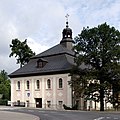Silesian prayer houses
Silesian prayer houses are built after 1742 (mostly in half-timbered construction without a bell tower) for Protestant worship in the (formerly Catholic) Silesian duchies. These prayer houses were allowed to call themselves churches from 1764.
prehistory
The Reformation spread quickly in Silesia as well . From 1526, more and more Protestant communities were formed. The Augsburg Religious Peace of 1555 secured the supporters of the Lutheran Church ( Augsburg Confession ) peace and property. In the course of the Counter Reformation , however, as part of the church reduction in the years 1654–1668, many (evangelical) churches were expropriated and re-Catholicized.
The Protestant residents in the Catholic duchies of Schweidnitz , Jauer , Sagan and Glogau often had to go long distances on "church trips" to reach Protestant border churches or churches of refuge . After the Thirty Years War (1648) three peace churches were built in Glogau , Jauer and Schweidnitz .
Through the Altranstädter Convention (1707), the Protestant residents of Silesia received 120 churches in the principalities of Liegnitz , Brieg , Wohlau , Münsterberg , Oels and on the outskirts of Breslau ( Rezesskirchen ). In addition, six grace churches (with a bell tower) were allowed to be built in the towns of Freystadt , Hirschberg , Landeshut , Militsch , Sagan and Teschen .
Origin of the prayer houses
Under Prussian rule in Silesia from 1742, the Protestant population was allowed to build or refurbish over 200 prayer houses in a simple baroque style (mostly in half-timbered construction), especially in the previously Catholic duchies of Schweidnitz, Jauer, Sagan and Glogau. Since they were created in the time of Frederick II, they are also known as "Friderizian Prayer Houses". Most of the prayer houses were later replaced by stone churches. After 1945 many of these prayer houses fell into disrepair, so that today there are hardly any old prayer houses. The heavily damaged prayer house in Schönwaldau (Rząśnik) is being restored by the Association for the Care of Silesian Culture and Art (VSK) and a copy is being rebuilt in Lomnitzer Park (Łomnica).
Places where houses of prayer were built
According to Friedrich Bernhard Werner (Parts I to V), prayer houses were built in the following locations:
Duchy of Schweidnitz
- Baumgarten (Sady Górne), Bolkenhain ( Bolków ), Dittmannsdorf ( Dziećmorowice ), Domanze ( Domanice ), Freiburg ( Świebodzice ), Friedland ( Mieroszów ), Giesmannsdorf (Gostków), Gottesberg ( Boguszów ), Gröditz bei Schweidnitz, Haselbach Helmsdorf or Langenhelmsdorf bei Jauer, Hohenfriedeberg ( Dobromierz ), Konradswaldau (Kondratów), Konradswaldau (Mrowiny), Langenbielau ( Bielawa ), Leutmannsdorf (Lutomia), Metschkau (Mieczków), Michelsdorf (Miszkowice), Ölse (Olszany) , Reichenau (Bogaczowice), Reichenbach ( Dzierżoniów ), Rohnstock ( Roztoka (Dobromierz) ), Röhrsdorf (Redziny), Rudelsdorf, Niedersalzbrunn ( Szczawienko ), Steinkunzendorf (Kamionki), Striegau ( Strzegom ), Waldenburg ( Wałbrzychnis ), Waltersdorf , Wederau (Wiadrów), Weistritz (Bystrzyca), Wernersdorf (Pakoszow), Wüstegiersdorf ( Głuszyca ).
Duchy of Jauer (Hirschberger Kreis)
- Arnsdorf ( Miłków ) Berbisdorf (Dziwiszów), Bober Roehrsdorf (Siedlecin), Buchwald ( Bukowiec ), Fischbach ( Karpniki ) Giersdorf ( Podgórzyn ) Hermsdorf under Kynast (Sobieszow) Jannowitz (Janowice) Kaiserswaldau (Piastów), purchase Fung ( Wojcieszów ), Kemnitz, Ketschdorf (Kaczorów), Konradswalde, Krommenau (Kromnów), Kupferberg (Miedzianka), Lomnica (Łomnica), Ludwigsdorf (Chrośnica), Maiwaldau (Maciejowa), Neukirch (Nowy Kościol), Petersdorf unterm Kynastice ( Piechowice ) , Schmiedeberg ( Kowary ) Schönau (Świerzawa), Good Waldau (Rząśnik) Schreiberhau ( Szklarska Poręba ) Seidorf (Sosnówka) Seifersdorf (Radomierz), page village (Poniatów), deep Hartmannsdorf (Podgórki) Voigtsdorf (Wojcieszyce) Warmbrunn ( Cieplice Śl. ).
Duchy of Jauer (Löwenberger and Bunzlauer district)
- Altgaschwitz, Altöls (Stara Oleszna), Aslau (Osla), Deutmannsdorf (Zbylutów), Flinsberg ( Świeradów ), Friedeberg am Queis ( Mirsk ), Giehren (Gierczyn), Giersdorf (Zeliszow), Görisseiffen, Groß Hartmanndorf (Kesselsdorfowice) Kotliska), Kunzendorf under the Kahlenberg, Kunzendorf under the forest, Langenau ( Czernica ), Langenoels ( Olszyna ), Leipe (Lipa), Lichtenwaldau (Krzyżowa), Löwenberg (Lwówek Śl.), Ottendorf (Ocice), Peterwitz, Pombsen (Pomocne) Prausnitz (Prusice), Rabishau (Rębiszów), Schönfeld (Podolany), Schosdorf (Ubocze), Seichau (Sichów), Seifersdorf (Łukaszów), Spiller (Pasiecznik), Steinkirchen, Thiemendorf (Radostów Dolny), Thomaswaldau (Tomaszów-Bolesławieckie), Tillendorf (Bolesławicz), Walditz, Warthau, Wiesenthal (Bystrzyca), Wünschendorf (Radomice), Zobten am Bober (Sobota).
Duchy of Glogau and Duchy of Sagan (and Schwiebuser Kreis)
- Beuthen ( Bytom Odrzański ), Boyadel (Bojadła), Carolath ( Siedlisko ), Dalkau (Dalków), Gießmannsdorf (Gościszowice), Gramschütz (Grebocice), Grochwitz (Grochowice), Großtschirme, Grünberg ( Zielona Góra ), Guhrau ( Góra ) near Freystadt (Jarogniewice), Herrndorf (Zukowice), Kontopp (Konotop), Kottwitz near Sagan (Kotowice), Kunzendorf (Sieroszowice), Liebenzig (Lubięcin), Lötnitz, Lübenau near Schwiebus, Malmitz (Małomice), Mühlbock near Schwiebus (Ołobok) , Naumburg am Bober ( Nowogród Bobrzański ), Neusalz ( Nowa Sól ), Neustädtel (Nowy Miasteczko), Niebusch (Niwiska), Ochelhermsdorf (Ochla), Polckwitz ( Polkowice ), Primkenau ( Przemków ), Quaritz (Gaworzycieb), Rückzyersdorf , Sabor (Ząbornia), Schlawa ( Sława ), Schmarse (Smardzewo), Schönau, Schweinitz ( Świdnica (Zielona Góra) ), Schwiebus ( Świebodzin ), Sprottau ( Szprotawa ), Stentsch near Schwiebus (Szczaniec), Struntz, Tschepplau (Krzepielow) , Weichau (Wichów), Wittgendorf near Sagan (Witków).
Wroclaw, civil lords and Upper Silesia
- Auras (Uraz), Dyhernfurth ( Brzeg Dolny ), Falkenberg ( Niemodlin ), Freyhan (Cieszkow), Goschitz (Goszcz), Grase, Groß Bargen , Hermsdorf, Kaulwitz, Lähn ( Wleń ), Leiten, Namslau ( Namysłów ), Neumarkt ( Środa) Śl. ), Peterwitz, Prausnitz (Prusice), Rackschütz (Rakoszyce), Rösnitz ( Rozumice ), Seifersdorf, Trachenberg ( Żmigród ), Wiltschau (Wilczkow).
Further prayer houses were built in: Laasan ( Łażany ), Saarau ( Zarow ), Wüstewaltersdorf ( Walim ), Langwaltersdorf ( Unisław Śląski ) as well as in Gnadenfeld ( Pawłowiczki , not until 1782) and Kammerswaldau (Komarno, not until 1772).
Pictures of Silesian prayer houses and prayer houses
See also
literature
- Friedrich Bernhard Werner: Silesian prayer houses. Part I to V, 1748-1752, Reprint, Hildesheim 1989, 469 pages, ISBN 3-7848-8922-0
- Reiner Sörries: By the grace of the emperor - Protestant church buildings in the Habsburg Empire. Böhlau Verlag, Cologne 2008, ISBN 978-3-412-20154-8 , 225 pp.
Web links
Individual evidence
- ^ Association for the Care of Silesian Culture and Art eV (VSK)
- ^ Friedrich Bernhard Werner: Silesian prayer houses. Part I to V, 1748-1752 Reprint, Hildesheim 1989, 469 pages, ISBN 3-7848-8922-0























